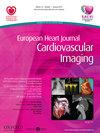The use of mechanical dyssynchrony for predicting response to cardiac resynchronization therapy in patients with non-ischemic cardiomyopathy
引用次数: 0
Abstract
Type of funding sources: None. Aim/Introduction: Assessment of mechanical dyssynchrony by myocardial perfusion gated-SPECT in patients with non-ischemic cardiomyopathy for predict response to cardiac resynchronization therapy (CRT). We examined 32 patients with non-ischemic cardiomyopathy before and six months after CRT. Left ventricular mechanical dyssynchrony and contractility were assessed for all patients by myocardial perfusion gated-SPECT. The phase standard deviation (PSD), histogram bandwidth (HBW), phase histogram skewness (S) and phase histogram kurtosis (K) were used as an indicator of mechanical dyssynchrony for the both ventricles. Mechanical dyssynchrony of both ventricles before CRT was increased in all patients. Median value PSD 53°(41-61°), HBW 176°(136-202°), S 1,62(1,21-1,89), K 2,81(1,21-3,49). Six months after CRT 22(68%) respondents were identified. We divided the patients into two groups (responders and non-responders) and compared phase parameters. It was found that the PSD (44°(35-54°)) and HBW (158°(118-179°) in the responders were significantly lower than in the non-responders (PSD (68°(58-72°); HBW (205°(199-249°)). The value of phase histogram skewness and kurtosis in responders were significantly higher (Responders: S 1,77(1,62-2,02); K 3,03(2,60-3,58). Non-responders: S 1,21(0,93-1,31); K 1,21(0,19-1,46)). We found that all four indicators of mechanical dyssynchrony can predict CRT response according to the results of univariate logistic regression analysis. Moreover, It was found that only phase histogram kurtosis (OR = 1.196, 95% CI 1.04-1.37) is an independent predictor of CRT response according to multivariate logistic regression. Radionuclide assessment of mechanical dyssynchrony may be the optimal diagnostic method for selecting patients with non-ischemic cardiomyopathy on CRT.非缺血性心肌病患者使用机械非同步化运动预测心脏再同步化治疗的反应
资金来源类型:无。目的/简介:通过心肌灌注门控spect评估非缺血性心肌病患者的机械非同步化,以预测对心脏再同步化治疗(CRT)的反应。我们对32例非缺血性心肌病患者在CRT前和CRT后6个月进行了检查。通过心肌灌注门控spect评估所有患者的左心室机械非同步化和收缩性。采用相位标准差(PSD)、直方图带宽(HBW)、相位直方图偏度(S)和相位直方图峰度(K)作为双心室机械非同步化的指标。所有患者在CRT前双心室机械非同步化均加重。中位值PSD 53°(41-61°),HBW 176°(136-202°),S 1,62°(1,21-1,89),K 2,81°(1,21-3,49)。在第22期(68%)应答者被确认后6个月。我们将患者分为两组(反应者和无反应者)并比较期参数。结果发现,应答者的PSD(44°(35 ~ 54°))和HBW(158°(118 ~ 179°))显著低于无应答者的PSD(68°(58 ~ 72°);HBW(205°(199 - 249°)。应答者的相位直方图偏度和峰度值显著高于应答者(S 1,77(1,62-2,02);K 3, 03(2 60-3 58)。无应答者:1,21(0,93-1,31);K 1, 21(0,之时价,46))。单变量logistic回归分析结果表明,机械非同步性的四个指标均能预测CRT反应。此外,根据多变量logistic回归,我们发现只有相位直方图峰度(OR = 1.196, 95% CI 1.04-1.37)是CRT反应的独立预测因子。放射性核素评估机械不同步运动可能是选择非缺血性心肌病患者的最佳诊断方法。
本文章由计算机程序翻译,如有差异,请以英文原文为准。
求助全文
约1分钟内获得全文
求助全文

 求助内容:
求助内容: 应助结果提醒方式:
应助结果提醒方式:


